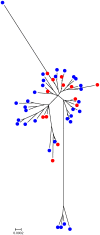Phylogenetic analysis reveals common antimicrobial resistant Campylobacter coli population in antimicrobial-free (ABF) and commercial swine systems
- PMID: 22984540
- PMCID: PMC3440321
- DOI: 10.1371/journal.pone.0044662
Phylogenetic analysis reveals common antimicrobial resistant Campylobacter coli population in antimicrobial-free (ABF) and commercial swine systems
Abstract
The objective of this study was to compare the population biology of antimicrobial resistant (AR) Campylobacter coli isolated from swine reared in the conventional and antimicrobial-free (ABF) swine production systems at farm, slaughter and environment. A total of 200 C. coli isolates selected from fecal, environmental, and carcass samples of ABF (n = 100) and conventional (n = 100) swine production systems were typed by multilocus sequence typing (MLST). Sequence data from seven housekeeping genes was analyzed for the identification of allelic profiles, sequence types (STs) and clonal complex determination. Phylogenetic trees were generated to establish the relationships between the genotyped isolates. A total of 51 STs were detected including two novel alleles (glnA 424 and glyA 464) and 14 novel STs reported for the first time. The majority of the C. coli isolates belonged to ST-854 (ABF: 31, conventional: 17), and were grouped in clonal complex ST-828 (ABF: 68%, conventional: 66%). The mean genetic diversity (H) for the ABF (0.3963+/-0.0806) and conventional (0.4655+/-0.0714) systems were similar. The index of association (I(A)(S)) for the ABF (I(A)(S)= 0.1513) and conventional (I(A)(S) = 0.0991) C. coli populations were close to linkage equilibrium, indicative of a freely recombining population. Identical STs were detected between the pigs and their environment both at farm and slaughter. A minimum spanning tree revealed the close clustering of C. coli STs that originated from swine and carcass with those from the environment. In conclusion, our study reveals a genotypic diverse C. coli population that shares a common ancestry in the conventional and ABF swine production systems. This could potentially explain the high prevalence of antimicrobial resistant C. coli in the ABF system in the absence of antimicrobial selection pressure.
Conflict of interest statement
Figures


Similar articles
-
Campylobacter coli: prevalence and antimicrobial resistance in antimicrobial-free (ABF) swine production systems.J Antimicrob Chemother. 2005 Oct;56(4):765-8. doi: 10.1093/jac/dki305. Epub 2005 Aug 24. J Antimicrob Chemother. 2005. PMID: 16120624
-
Longitudinal study of the persistence of antimicrobial-resistant campylobacter strains in distinct Swine production systems on farms, at slaughter, and in the environment.Appl Environ Microbiol. 2012 Apr;78(8):2698-705. doi: 10.1128/AEM.07723-11. Epub 2012 Feb 3. Appl Environ Microbiol. 2012. PMID: 22307299 Free PMC article.
-
Prevalence and antimicrobial resistance profile of Campylobacter spp. isolated from conventional and antimicrobial-free swine production systems from different U.S. regions.Foodborne Pathog Dis. 2011 Mar;8(3):367-74. doi: 10.1089/fpd.2010.0665. Epub 2010 Dec 6. Foodborne Pathog Dis. 2011. PMID: 21133777
-
Prevalence and antimicrobial resistance of Campylobacter in antimicrobial-free and conventional pig production systems.J Food Prot. 2005 Nov;68(11):2402-10. doi: 10.4315/0362-028x-68.11.2402. J Food Prot. 2005. PMID: 16300080
-
Phenotypic and genotypic heterogeneity of Campylobacter coli within individual pigs at farm and slaughter in the US.Zoonoses Public Health. 2010 Nov;57 Suppl 1:100-6. doi: 10.1111/j.1863-2378.2010.01363.x. Zoonoses Public Health. 2010. PMID: 21083823
Cited by
-
No Clear Differences between Organic or Conventional Pig Farms in the Genetic Diversity or Virulence of Campylobacter coli Isolates.Front Microbiol. 2017 Jun 26;8:1016. doi: 10.3389/fmicb.2017.01016. eCollection 2017. Front Microbiol. 2017. PMID: 28694791 Free PMC article.
-
Genomic Insights into the Mobilome and Resistome of Sentinel Microorganisms Originating from Farms of Two Different Swine Production Systems.Microbiol Spectr. 2022 Dec 21;10(6):e0289622. doi: 10.1128/spectrum.02896-22. Epub 2022 Nov 15. Microbiol Spectr. 2022. PMID: 36377950 Free PMC article.
-
Comparative analysis of quinolone resistance in clinical isolates of Klebsiella pneumoniae and Escherichia coli from Chinese children and adults.Biomed Res Int. 2015;2015:168292. doi: 10.1155/2015/168292. Epub 2015 Feb 10. Biomed Res Int. 2015. PMID: 25756041 Free PMC article.
-
High Prevalence of Fluoroquinolone-Resistant Campylobacter Bacteria in Sheep and Increased Campylobacter Counts in the Bile and Gallbladders of Sheep Medicated with Tetracycline in Feed.Appl Environ Microbiol. 2019 May 16;85(11):e00008-19. doi: 10.1128/AEM.00008-19. Print 2019 Jun 1. Appl Environ Microbiol. 2019. PMID: 30926726 Free PMC article.
-
Diversity of Campylobacter spp. circulating in a rhesus macaque (Macaca mulatta) breeding colony using culture and molecular methods.mSphere. 2024 Nov 21;9(11):e0056024. doi: 10.1128/msphere.00560-24. Epub 2024 Oct 23. mSphere. 2024. PMID: 39440965 Free PMC article.
References
-
- Hermans D, Pasmans F, Messens W, Martel A, Van Immerseel F, et al. (2012) Poultry as a host for the zoonotic pathogen Campylobacter jejuni . Vector Borne Zoonotic Dis 12: 89–98. - PubMed
-
- Grove-White DH, Leatherbarrow AJ, Cripps PJ, Diggle PJ, French NP (2010) Temporal and farm-management-associated variation in the faecal-pat prevalence of Campylobacter jejuni in ruminants. Epidemiol Infect 138: 549–558. - PubMed
Publication types
MeSH terms
Substances
LinkOut - more resources
Full Text Sources
Research Materials

